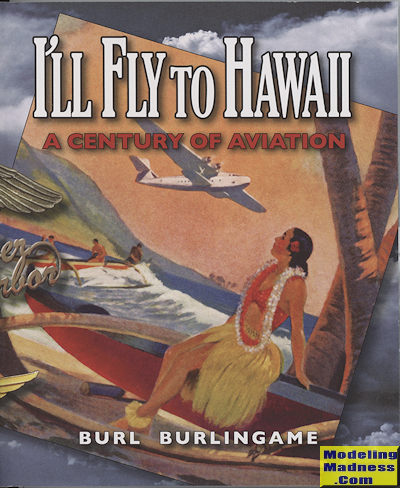Pacific Monograph's I'll Fly to Hawaii
|
AUTHOR#: |
Burl Burlingame |
|
PRICE: |
$9.95 |
|
PUBLISHER: |
Pacific Monograph |
|
REVIEWER: |
Scott Van Aken |
|
NOTES: |
Softcover, 5x6 inches, 144 pages
ISBN: 978-0-9629227-6-3
|
 This
is a neat book that basically tells the story of aviation in Hawaii. One doesn't
really think about Hawaii when it comes to early aviation and while it started a
bit later there than other places, there were people who were air minded and who
saw the advantage that aircraft could provide.
This
is a neat book that basically tells the story of aviation in Hawaii. One doesn't
really think about Hawaii when it comes to early aviation and while it started a
bit later there than other places, there were people who were air minded and who
saw the advantage that aircraft could provide.
In common with other
parts of the world the first to take to the air were balloonists, though thanks
to the pretty constant winds and terrain, ballooning did not become a staple.
However, it was a start. With the coming of heavier than air flight, in 1910 the
first aircraft arrived. This consisted of two Curtiss pusher types which were
demonstrated by Bud Mars before he left the island and headed to Japan. This
aroused interest and an increasing number of people brought a variety of types,
mostly flying from the Honolulu area.
All of this aviation activity eventually
got the military interested and in 1913, the Army brought aircraft to Oahu.
These were initially floatplanes and their basing was quite primitive with the
troops living in tents. The beginning of WWI and the eventual American
involvement saw a considerable increase in both the number and size of aircraft
flying out of Oahu.
During the interwar years, businessmen saw
the benefit of aircraft when it came to inter-island commerce and a number of
airlines started up. These would carry passengers and cargo, though the costs
were considerably higher than going by ship. Early flying was also fraught with
danger with the military estimating that about 40% of their pilots would be
killed during their aviation career. It also saw an increase in the Navy's
interest in aviation in the islands, which had started as just being the purview
of the Army.
Record breaking flights of the 20s and 30s
brought even more interest to Hawaii as several of the more famous around the
world and trans-Pacific flights staged through Hawaii. The 1930s brought a
greater increase in the Navy's presence in Hawaii and the Army built a number of
additional air fields, mostly on Oahu. Civilian fields were built on all the
major islands as air travel became more popular.
WWII meant a greater concentration of
military on the islands, particularly Oahu with the Pearl Harbor Naval base and
the various USAAF repair depots. Many units due for the Pacific were established
in Hawaii before leaving for the war zone.
By the time of the end of the war, air
travel was becoming commonplace and so commercial aviation expanded
considerably. As the Cold War drew to an end, many military bases that were so
important during that time period were deemed excess and closed, with the
airfields being turned over to local governments.
In this book, the author does a splendid
job of telling the story of Hawaiian aviation. The book is obviously well
researched and is one that I found interesting to read. There are great photos
and fascinating stories of the early pioneers. Not surprisingly, the majority of
the book focuses on the years leading up to WWII when aviation was still in its
pioneering phase. After the war, aviation became more mundane and so only the
important events are covered.
It all makes for a book that covers an
aspect of aviation history of which few are aware. It is a fascinating read and
one that I can highly recommend.
October 2016
Copyright
ModelingMadness.com
Thanks to www.pacificmonograph.com for the review book. You can get yours
at
this link.
If you would like your product reviewed fairly and fairly quickly, please contact the editor or see other details in the
Note to
Contributors.
Back to the Main Page
 This
is a neat book that basically tells the story of aviation in Hawaii. One doesn't
really think about Hawaii when it comes to early aviation and while it started a
bit later there than other places, there were people who were air minded and who
saw the advantage that aircraft could provide.
This
is a neat book that basically tells the story of aviation in Hawaii. One doesn't
really think about Hawaii when it comes to early aviation and while it started a
bit later there than other places, there were people who were air minded and who
saw the advantage that aircraft could provide.